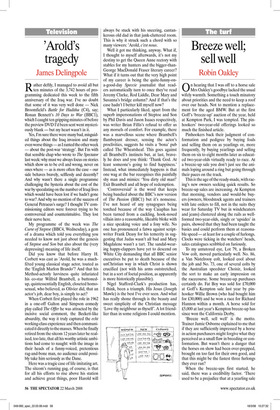Breeze well; sell well
Robin Oakley
On hearing that I was off to a horse sale Mrs Oakley’s goodbye lacked the usual wifely warmth. Something a touch minatory about priorities and the need to keep a roof over our heads. Not to mention a replacement for the aged BMW. But at the first Goff’s ‘breeze-up’ auction of the year, held at Kempton Park, I was tempted. The pinhookers’ two-year-old offerings looked so much the finished article.
Pinhookers back their judgment of conformation and pedigree by buying foals and selling them on as yearlings or, more frequently, by buying yearlings and selling them on six to eight months later as educated two-year-olds virtually ready to race. At a breeze-up sale you don’t just see the animals loping around a ring but going through their paces on the track.
This is the age of the ready-made, with racing’s new owners seeking quick results. So breeze-up sales are increasing. At Kempton that morning, vendors and would-be buyers (owners, bloodstock agents and trainers with late orders to fill, not in the suits they wear for Saturday TV but in windcheaters and jeans) clustered along the rails as wellformed two-year-olds, singly or ‘upsides’ in pairs, showed that they had been taught the basics and could perform them at reasonable speed — at least for a couple of furlongs. Clocks were ticking in the watchers’ heads, sales catalogues scribbled on furiously.
To my untutored eye, Lot 79, a Broken Vow colt, moved particularly well. No. 86, a Van Nistelrooy colt, looked cool about the job and No. 73, one of several colts by the Australian speedster Choisir, looked the sort to make an early impression on the racecourse. Some breeze-up purchases certainly do. Fat Boy was sold for £70,000 at Goff’s Kempton sale last year by pinhooker Willie Brown (who had bought him for £30,000) and he won a race for Richard Hannon within a month. A horse sold for £5,000 at last year’s Kempton breeze-up has since won the California Derby.
‘Breeze well, sell well’ is the motto. Trainer Jamie Osborne explained to me that if they are sufficiently impressed by a horse in action purchasers might forgive what they perceived as a small flaw in breeding or conformation. But wasn’t there a danger that the horses on show had been over-prepped, brought on too fast for their own good, and that this might be the fastest three furlongs they ever ran?
When the breeze-ups first started, he said, there was a credibility factor. ‘There used to be a prejudice that at a yearling sale you were buying a new car, at a two-year-old breeze-up you were buying a secondhand one. In the end it comes down to a judgment call... and the most important part is knowing your vendors.’ Manton trainer Brian Meehan agreed some could be tempted to hurry their horses. ‘But these vendors are experienced. They have serious operations. Pinhooking has come on in leaps and bounds and they’ve got polytracks at home, swimming-pools, top-class facilities.’ So what was he looking for? ‘You can tell how a horse moves, you try to clock them to see if they’ve got any speed. Sometimes they can be a little bit sore so they must have moved well and gone well.’ He was actually looking for resale value, having two orders for horses destined to be reoffered later at a horses-in-training sale. In racing the wheel keeps turning.
No pinhooker who wants to make a living wants to sell horses which fail. Con Marnane from Bansha House Stables in County Tipperary has sold three Group One winners in the past three seasons — Palace Episode, Rio de la Plata and Amadeus Wolf. His job, he told me, was to build as much muscle as possible with slow, steady work, and to hand a trainer horses that were easy to manage. Certainly the Kempton Polytrack suited them all. Horses seem to float over it when it might be hard on soggy turf to assess a two-year-old’s real ability. And Henry Beeby, Goff’s chief executive, explained that to produce the hundred horses at the auction nearly 400 had been inspected.
After the breeze-up, the close-up. In the stable yard the horses were brought out of their boxes for deeper scrutiny. They were checked over by vets, walked and trotted on request, and had their legs felt more often than a lap dancer. Grooms walked them out of the shade so that the sunlight reflected off their coats and painted their hooves a brighter black. Little knots of observers tapped their teeth and conferred in monotones — French and Italian as well as English.
Then it was up to the restaurant for the bidding, the climbing prices recorded on screens as a high-decibel Henry Beeby, seemingly without taking breath, rattled out his rapid-fire exhortations to bidders with a vigour which, if applied to horses, would have had him up before the stewards for excessive use of the tongue.
No. 79 went for £65,000 to BHA chief Paul Roy and No. 86 for what looked like a bargain £15,000. Con Marnane’s No. 73 was not sold but another he had pinhooked for £50,000 went for twice that. I had just one nasty moment, the moment we all dread at an auction. One lot was knocked down for £33,000, just after I had pulled a red-spotted handkerchief from my pocket. ‘Thank you, Robin,’ boomed the auctioneer through the public address. Oh my God, he hadn’t thought, had he? Then, thankfully, he added ‘Sold to Robin O’Ryan.’ Mrs Oakley would still be speaking to me. And perhaps we will get that new car after all...



















































































 Previous page
Previous page